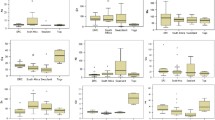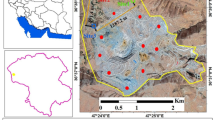Abstract
The purpose of this study was to assess the oral bioavailability of lead in soil collected from a former smelter site in Sandy, Utah, USA. Sprague-Dawley rats (approximately 4 weeks of age, 5 of each sex in group) were given either soil lead or lead acetate mixed in a purified diet (AIN-93G ™) at four different concentrations for 31 consecutive days. Food consumption measurements were used to compute mean daily lead exposures for the soil lead and lead acetate groups. The lead acetate treatment yielded higher concentrations of lead in the blood and bone than the soil lead treatment. Mean blood lead values ranged from below the detection limit (3 μg dL−1) to 27.25 μg lead dL−1 for the lead acetate groups at dose levels of 0.10–2.91 mg lead kg body weight−1 and from below the detection limit to 8.8 μg lead dL−1 for the soil lead groups at doses of 0.11–3.43 mg lead kg body weight−1. At these same doses, mean bone values ranged from 0.52 to 26.92 μg lead g−1 for the lead acetate groups and from 0.64 to 13.1 μg lead g−1 for the soil lead groups. Relative per cent bioavailability was estimated by modelling the dose-blood concentration curves for the lead acetate treatment and the dosed soil lead treatment, and then comparing doses that produce an equivalent blood lead concentration. The ratio of the doses of lead acetate and soil lead that produced the same tissue response (i.e., concentration) provided an index of relative bioavailability. For lead, the bioavailability of soil lead relative to lead acetate was 41% at a blood concentration of 6 μg lead dL−1.
Similar content being viewed by others
References
BSBDOH and UCDEH. 1992.The Butte-Silver Bow Environmental Health Lead Study. Final Report. Butte-Silver Bow Department of Health, Butte, Montana, and University of Cincinnati, Department of Environmental Health, Cincinnati, OH.
Chaney, R.L. 1990. Acidity of stomach secretions in humans, rats, and pigs, and the potential importance of stomach pH in bioavailability of Pb in soils and mine wastes. Unpublished memorandum.
Davis, A., Drexler, J.W., Ruby, M.V. and Nicholson, A. 1993. Micromineralogy of mine wastes in relation to lead bioavailability, Butte, Montana.Environmental Science and Technology,27, 1415–1425.
Dieter, M.P., Matthews, H.B., Jeffcoat, R.A. and Moseman, R.F. 1993. Comparisons of lead bioavailability in F344 rats fed lead acetate, lead oxide, lead sulfide, or lead ore concentrate from Skagway, Alaska.Journal of Toxicology and Environmental Health,39, 79–93.
Dieter, M.P., Chabra, R.S., Freeman, G.B., Liao, S., Ryan, M.J. and Kurtz, P.J. 1994. Bioaccumulation of tissue lead in F344 rats fed diets with PbS or mine ores.The Toxicologist,14(1), 561.
Freeman, G.B., Johnson, J.D., Liao, S.C., Feder, P.I., Davis, A.O., Ruby, M.V., Schoof, R.A., Chaney, R.L. and Bergstrom, P.D. 1994. Absolute bioavailability of lead acetate and mining waste lead in rats.Toxicology,91, 151–163.
Freeman, G.B., Johnson, J.D., Killinger, J.M., Liao, S.C., Feder, P.I., Davis, A.O., Ruby, M.V., Chaney, R.L., Lovre, S.C. and Bergstrom, P.D. 1992. Relative bioavailability of lead from mining waste soil in rats.Fundamental and Applied Toxicology,19, 388–398.
Ghantous, H., Bingman, T., McCleary, K. and Bogdanffy, M. 1994. Microswine as a model for lead bioavailability in children.The Toxicologist,14(1), 560.
Jorgensen, S.E. 1991.Modeling in Environmental Chemistry. Elsevier, New York.
Ma, O., Traina, S.J. and Logan, T.J. 1993.In situ lead immobilization by apatite.Environmental Science and Technology,27, 1803–1810.
Poppenga, R., Weis, C., Henningsen, C., Thacker, B., Harpstead, T., Jolly, R. and Byron, J. 1994. Features of an immature-swine model for children to evaluate oral soil-lead absorption.The Toxicologist,14(1), 396.
Ruby, M.V., Davis, A., Link, T.E., Schoof, R., Chaney, R.L., Freeman, G.B. and Bergstrom, P. 1993. Development of anin vitro screening test to evaluate thein vivo solubility of ingested mine-waste lead.Environmental Science and Technology,27, 2870–2877.
Ruby, M.V., Davis, A. and Nicholson, A. 1994.In situ formation of lead phosphates in soils as a method to immobilize lead.Environmental Science and Technology,28, 646–654.
Smuggler Mountain TAC. 1993.Final Report. Smuggler Mountain Technical Advisory Committee.
US EPA. 1983.Methods for Chemical Analysis of Water and Wastes. EPA-600/4-79-020. US Environmental Protection Agency, Washington DC.
US EPA. 1986a.Air Quality Criteria for Lead. EPA 600/8-83-028F. US Environmental Protection Agency, Office of Research and Development, Office of Health and Environmental Assessment, Environmental Criteria and Assessment, Research Triangle Park, NC.
US EPA. 1986b.Test Methods for Evaluating Solid Waste. Volumes 1A and 1B;Laboratory Manual Physical/Chemical Methods. SW-846. Third Edition. US Environmental Protection Agency, Office of Solid Waste and Emergency Response, Washington DC.
US EPA. 1994.Salt Lake County Smelter Initiative, Phase II Workplan, Sandy, UT. EPA Project No. T089210-025, Contract No. 68-WO-0037. US Environmental Protection Agency, Washington DC.
Weis, C.P., Poppenga, R.L., Thacker, B.J., Henningsen, G.M., Curtis, A., Jolly, R. and Harpstead, T. 1994. Pharmacokinetics of soil-lead absorption into immature swine following subchronic oral and IV exposure.The Toxicologist 14(1), 395.
Wilkinson, L. 1990.SYSTAT: The System for Statistics. SYSTAT, Inc., Evanston, IL.
Author information
Authors and Affiliations
Rights and permissions
About this article
Cite this article
Schoof, R.A., Butcher, M.K., Sellstone, C. et al. An assessment of lead absorption from soil affected by smelter emissions. Environ Geochem Health 17, 189–199 (1995). https://doi.org/10.1007/BF00661331
Accepted:
Issue Date:
DOI: https://doi.org/10.1007/BF00661331




